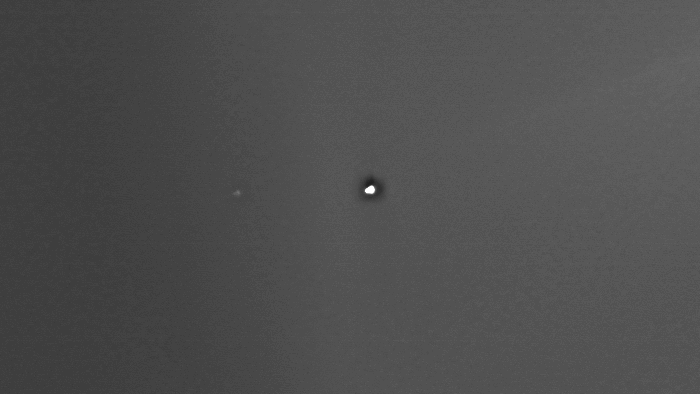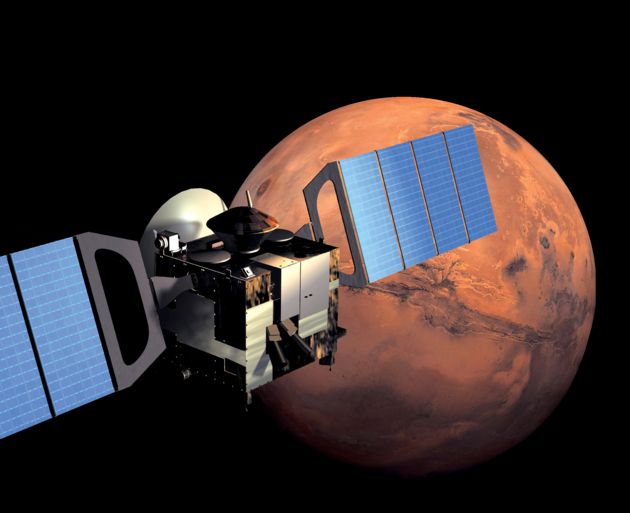Mars orbiter spies a tiny Earth and moon from the Red Planet (photos)
The European Space Agency spacecraft celebrated its 20th anniversary by taking a nostalgic glance back at its planet of origin.

You've never seen Earth and the moon like this before.
The Mars Express spacecraft recently celebrated 20 years in space by taking a nostalgic look back at Earth and the moon from the Red Planet. The images captured by the European Space Agency (ESA) craft show our planet and its natural satellite as little more than a large white dot crossed by a smaller white dot.
And while this may not be the most spectacular image from space ever seen, the Mars Express picture demonstrates the distance between Earth and the Red Planet and what an achievement it is to put vehicles on and around our neighbor planet.
Related: The climate of Mars changed dramatically 400,000 years ago, Chinese rover finds
The images elicit comparisons to the famous image of Earth taken in Feb. 1990 by the Voyager 1 spacecraft, in which our planet also appeared as little more than a speck, which has been dubbed the "Pale Blue Dot." The image moved astronomer and science communicator Carl Sagan to reflect on the fragility of Earth and humanity's responsibility to care for the only planet we know to harbor life. And even though three decades have passed since Sagan elucidated that message, it has never seemed more important.
"On the special occasion of Mars Express's 20th anniversary since launch, we wanted to bring Carl Sagan’s reflections back to the present day, in which the worsening climate and ecological crisis make them more valid than ever," part of the team behind the image and University of the Basque Country researcher Jorge Hernández Bernal said in a statement.
"In these simple snapshots from Mars Express, Earth has the equivalent size as an ant seen from a distance of 100 meters, and we are all in there. Even though we have seen images like these before, it is still humbling to pause and think: We need to look after the pale blue dot, there is no planet B."
Get the Space.com Newsletter
Breaking space news, the latest updates on rocket launches, skywatching events and more!
The Mars Express spacecraft set off from Russia's Baikonur Cosmodrome launch complex in Kazakhstan on June 2, 2003. The Mars Express caught its first image from space on July 3, 2020, as it looked back at Earth and the moon when it was just 5 million miles (8 million kilometers) from home.

The Mars Express spacecraft arrived in orbit around Mars in December of the same year, settling into its highly elliptical orbit on Christmas Day 2003. And as this new image, which was captured around 186 million miles (300 million kilometers) from Earth, shows the Mars orbiter has since been the Christmas gift that keeps giving for planetary scientists ever since.

These particular images were captured using the super-resolution channel (SRC) of Mars Express's High-Resolution Stereo Camera (HRSC). The main role of this instrument has been to observe the two moons of Mars and the background stars around the Red Planet.
The images of Earth and the moon were captured on May 15, May 21, and June 2, 2023, and thus encompass over half of the 29.5-day orbit of the moon around our planet. The final image was taken just before a special event during which the Mars Express beamed images taken by its Visual Monitoring Camera (VMC) for a first-of-its-kind "live from Mars" anniversary broadcast.
"There is no scientific value in these images, but since the conditions allowed us to point the HRSC to Earth and shortly after the VMC to Mars, we took the opportunity to create our own portrait of home on this incredible mission milestone for Mars Express," member of the Mars Express team at the German Aerospace Center Daniela Tirsch said.
The Mars Express may have been away from Earth for a full two decades, but the ESA spacecraft still has much work to do before its retirement. The mission has been granted several extensions, the latest of which was approved in March this year and will see the Mars Express operating until Dec. 31, 2026, at the very least.
"ESA has a long history of Mars exploration, first from orbit with Mars Express and the Trace Gas Orbiter, and in the next decade on the surface with the Rosalind Franklin rover and the completion of the Mars Sample Return missions. The next bold ambition is, of course, to explore with humans," ESA project scientist for Mars Express and the ExoMars Trace Gas Orbiter, Colin Wilson, said. "Perhaps it will only be another 20 years before humans can look up from the surface of Mars to see Earth in the night sky."
Join our Space Forums to keep talking space on the latest missions, night sky and more! And if you have a news tip, correction or comment, let us know at: community@space.com.

Robert Lea is a science journalist in the U.K. whose articles have been published in Physics World, New Scientist, Astronomy Magazine, All About Space, Newsweek and ZME Science. He also writes about science communication for Elsevier and the European Journal of Physics. Rob holds a bachelor of science degree in physics and astronomy from the U.K.’s Open University. Follow him on Twitter @sciencef1rst.
-
UFOareAngels bullspit if they don't show us a full clear picture of earth then the flat earthers will never stop.Reply









